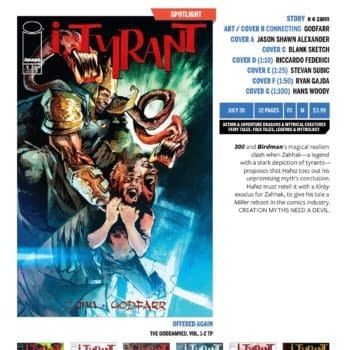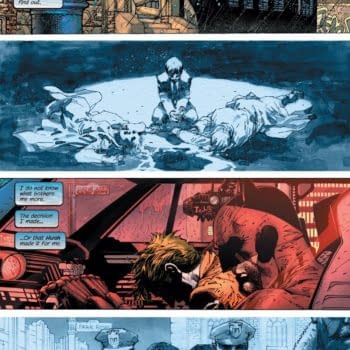Posted in: Comics | Tagged: Comics, Dia ja, entertainment, Glow, kickstarter, Ray Chou, Vincenzo Ferriero
Could Your Video Pitch Make The Difference For Your Kickstarter?
Vincenzo Ferriero writes for Bleeding Cool about his Kickstarter.
Hey guys! My name is Vince and I am one of the creators of the Glow comic that is currently out on Kickstarter. Please check us out if guns and golems, mutants and magic, witches and warlords are your thing.
If you've found yourself here, you most likely wish to kickstart a project of your own or might just be interested in what we do. This is our fourth time back on the platform, and I thought it would be cool to share some ideas that worked for us in making our projects a success. So let's jump right in!
Why have a good video?
Kickstarter is an awesome platform for indie comic creators to make their stories come true. Not only is the comic section of Kickstarter quite healthy, but you can show off pages and concept art to really stir the crowd into helping it make it happen. The visual aspect of comics is much more powerful than just writing out a story synopsis and a paragraph on how it will look.
At the top of each campaign, you also have a space to drop in a video.
This isn't necessary, but is a great way to make an awesome first impression, and you only get one chance at that. A video can show your passion for the project, add a fitting tone for your work through music, and offer a concise explanation of your goals and story.
Ray, my co-writer, and I are staunch believers in using the video element to its fullest potential. We both graduated from film school, so we understood its importance going in.
Here are our top 5 tips of making your video on Kickstarter.
1. If you gotta shoot, shoot. Don't talk…
In this modern age of HD digital cameras and fiber-optic internet, viewers have come to expect quality when they press play on a video. You might be strapped for cash (probably why you are kickstarting in the first place), but getting good quality equipment is a firm investment into making good videos and bringing in more funds for your magnum opus.
Your video should mirror your project in quality. It's a way viewers can gain confidence in what you do, and assures them that you are in full control of what you are presenting. Seeing your face for the first time with some great lighting and HD goodness is a good start for any kickstarter. It makes your video approachable and lends a face behind the project.
Of course, quality comes with a price. For Ray and I, we use the Nikon D7000 from our film school days. It's a solid DSLR camera that offers 1080p video and was pretty competitive in quality back in 2010. Since then, better (and cheaper) cameras have come out, so you have a better assortment of toys to pick from.
If you intend to use Kickstarter as a continuing source of funds for your projects, I recommend checking out some tech blogs and finding the DSLR that is right for you. If dishing out $900 on a new gadget isn't your thing, check out your local video equipment rental. DSLR kits often go for as low as 50 dollars a day. A little film school secret: rent out the equipment on a Friday. As shops are usually closed for the weekend, you'd only have to pay for that day and be able to keep the equipment until Monday.
2. Aziz, Light!
The next thing is lighting. Sure, you could shoot outside on a sunny day, but you've got uncontrollable factors like wind and sound. You'd want to shoot somewhere where it's quiet, and you are undisturbed. Even with a quality camera, low/bad lighting can break your video. But, don't worry. There is a cheap solution to this – the China Ball!
This wonderful contraption can be picked up at your local hardware store for as little as 15 dollars! Stick a 200W bulb in one of these paper lanterns and you've got some amazing soft light for your video. They even use these things on blockbuster films, like The Dark Knight. Hey, if it's good for Bats, it's good for us!
3. Can you hear me now?
This is one thing even filmmakers sometimes forget about. Directors often care more about getting good video than capturing good sound. After all, you can always "fix" the sound in post, right?
True, but you don't want to go there. It is painstaking work, and the result can actually be terrible. Let's make it clear:
SOUND IS JUST AS, IF NOT, MORE IMPORTANT THAN THE VIDEO!
Bad sound can be distracting, and at times, unnerving. The hiss from a camera microphone is enough to make someone click the back button. It's also a telltale sign of an amateur video.
To fix the problem, we use the Audio Technica ATR 3350 Condenser Lavalier. Don't worry about the name. All you have to know is that it's easy to use, produces nice sound, and is dirt-cheap!
At about 36 dollars, this is a bargain! The jack plugs into a standard mic input. Just switch it on and off you go. You've got a good cord distance, and its small size ensures that you can hide it under your collar.
4. Short and Sweet
All right, so we have a camera, our awesome China ball, and a microphone clamped to our chest. We shoot the video. Great! What next?
Time to edit your video! I use Final Cut Pro 7 to edit our videos. It's professional grade and really intuitive to use once you get a hang of it. You don't need to go so far to cut your video together. As long as you have the time and are willing to put the effort, any editing software will suffice.
What's more important is what you do with your edits.
– Keep your video short! 2-3 minutes is the sweet spot for us. Anything longer and you're going to send people to sleep. This is also enough time to bang out your story idea and maybe some important info you want your viewers to know.
– For us, 70% comic images and 30% interviews seemed like a good mix. The focus should be the comic after all, not the creators. Often, it's nice to start off with an interview shot and then move to the comic. This allows you to continue talking over the images so people have a reference for the voice while getting a chance to see your work.
– The first 15-20 seconds of the video is a great place to have your best panels (preferably sequenced in a way to tell a story or create tension). These valuable seconds are important to draw the viewer in and get them riled up to watch more.
– The final few seconds of the video are important to. Often placing an awesome final image is a great send off for viewers who are unsure if they want to support you or not. It will remain with them and hopefully sway them to back your project later down the road.
5. Soundtrack and Effects
Cool, so you have your images and your interviews put together in a rough video. Now comes time to finesse the work. Ray and I always want our videos to be as dynamic as possible in order to capture the tone and mood of the comic we are presenting. We do this in two ways: music and easy motion effects on our comic panels.
– For your background soundtrack, pick something that fits the tone of your piece. Be it a slow melody or an intense drum and base, it is the perfect way to give your imagery that vitality it might otherwise be missing. For music, we look through Kevin McLeod's website. He's an awesome musician who has a royalty-free selection as long as you credit him in the video.
– Music choice is essential as it sets the rhythm of your video. Make cuts between shots and images on important moments in the video. Is the music rising to an epic crescendo? Stick in that shot of an epic sky battle! It's always a good idea to cut between melodic shifts in a piece.
– With images, don't just have a static shot. Let it move! Have a sweeping landscape, pan across the image to accentuate that. Have a somber moment between two characters? Slowly zoom in on that image. Have an amazing world map? Zoom out so that the scale really shows.
I hope you guys enjoyed this post and found something handy in order to help you on your own Kickstarter adventure! And please check out our current Kickstarter here.
If you have any thoughts or questions, please feel free to comment or message us at www.mythopoeia.us/contact.
Till next time, keep glowing!
Vince


















